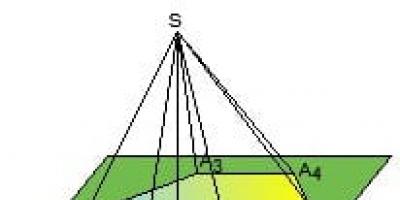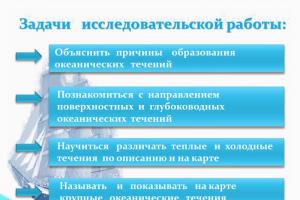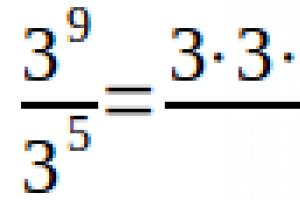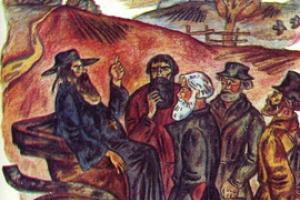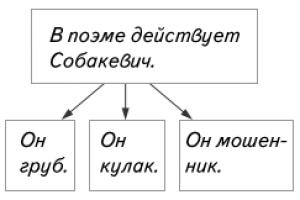Lecture outline
5.1. Classical theory of electrical conductivity of metals.
5.2. Derivation of Ohm's law and Joule-Lenz law.
5.3. Disadvantages of the classical theory of electrical conductivity of metals.
Classical theory of electrical conductivity of metals
Any theory is considered complete only if it traces the path from the elementary mechanism of a phenomenon to the macro-relations found in it that are used in technical practice. In this case, it was irresistible to connect the features of the ordered movement of free charges in a conductor (electrical conductivity) with the basic laws of electric current. First of all, it was necessary to find out the nature of current carriers in metals. Fundamental in this sense were the experiments of Rikke 1, in which for a long time ( ≈ year) current was passed through three metal cylinders connected in series ( Cu, A1, Cu) of the same cross-section with carefully polished lapped ends. A huge charge (≈ 3.5·10 6 C) flowed through this chain. Despite this, no (even microscopic) traces of substance transfer from cylinder to cylinder were found (which was confirmed by careful weighing). From this it was concluded that in metals the process of electric charge transfer involves some particles that are common (identical) to all metals.
The nature of such particles could be determined by the sign and magnitude of the specific charge (the ratio of the charge of the carrier to its mass) - an individual parameter for any of the microparticles known today. The idea of such an experiment is as follows: when a metal conductor is sharply decelerated, current carriers weakly connected to the lattice should move forward by inertia. The result of such a displacement is a current pulse, and from the direction of the current one can determine the sign of the carriers and, knowing the dimensions and resistance of the conductor, the specific charge of the carriers can be calculated. Such experiments yielded ratio values that coincided with the specific charge of the electrons. Thus, it was finally proven that the carriers of electric current in metals are free electrons. When a crystal lattice of a metal is formed (when isolated atoms approach each other), valence electrons weakly bound to the nuclei are detached from the metal atoms, become “free” and can move throughout the entire volume. Thus, metal ions are located at the nodes of the crystal lattice, and free electrons move chaotically between them.
The founders of the classical theory of electrical conductivity of metals, Drude 2 and Lorentz 3, were the first to show that any set of non-interacting microchases
Rikke Karl Victor Eduard (1845 – 1915), German physicist
2 Drude Paul Karl Ludwig (1863 – 1906), German physicist
3 Lorenz Hendrik Anton (1853 – 1928), Dutch theoretical physicist
particles (including free electrons in a metal) can be considered as an ideal gas, that is, all the conclusions of the molecular kinetic theory are applicable to free electrons in a metal.
During their movement, conduction electrons collide with lattice ions, as a result of which thermodynamic equilibrium is established between an ideal gas of free electrons and the lattice. The average speed of free electrons can be found in accordance with the expression for the arithmetic average speed of the chaotic thermal motion of ideal gas molecules (see formula (8.26) in Lecture 8, Part I):
which at room temperatures (T ≈ 300 K) gives<u> = 1.1·10 5 m/s.
When an external electric field is applied to a conductor, in addition to the thermal movement of electrons, their ordered movement, that is, an electric current, also arises. The average speed of ordered movement of electrons -<v> can be determined according to (4.4). At the maximum permissible current density in real conductors (≈ 10 7 A/m 2), a quantitative assessment gives<v> ≈ 10 3 -10 4 m/s. Thus, even in extreme cases, the average speed of ordered motion of electrons (causing electric current) is significantly less than their speed of chaotic thermal motion (<v> << <u>). Therefore, when calculating the resulting speed, we can assume that (<v> + <u>) ≈ <u>. It was already noted above that the ultimate goal of the classical theory of electrical conductivity of metals is the derivation of the basic laws of electric current, based on the considered elementary mechanism of movement of current carriers. As an example, consider how this was done when deriving Ohm's law in differential form.
5.2. Derivation of Ohm's law and Joule–Lenz law
Let there be an electric field with intensity in a metal conductor. From the field side, the electron experiences the action of the Coulomb force F = eE and gains acceleration. According to Drude's theory, at the end of the mean free path<l> an electron collides with a lattice ion and releases the energy accumulated during its movement in the field (the speed of its ordered movement becomes equal to zero). Moving uniformly accelerated, the electron acquires a speed at the end of its free path ![]() , Where
, Where
Because (<v> + <u>) ≈ <u>, then ![]() and (5.1) takes the form
and (5.1) takes the form ![]() . Thus, the current density, according to (4.4), can be represented as
. Thus, the current density, according to (4.4), can be represented as
![]() . (5.2)
. (5.2)
Comparing this expression with Ohm's law in differential form, one can see that these expressions are identical provided that the conductivity
Thus, within the framework of the classical theory of electrical conductivity of metals, Ohm’s law was derived in differential form.
The Joule-Lenz law was derived similarly, a quantitative relationship was obtained between specific conductivity and thermal conductivity, taking into account the fact that in metals the transfer of electricity and heat is carried out by the same particles (free electrons) and a number of other relationships.
Experiments carried out by Rikke in 1901, Mandelstam and Papaleksi in 1913, and Tolman and Stewart in 1916 showed that current carriers in metals are electrons. Current in metals can be caused by an extremely small potential difference. This gives reason to believe that electrons move throughout the metal almost freely. The appearance of these free electrons is explained by the fact that during the formation of a crystal lattice, the weakest bound valence electrons are easily detached from metal atoms. It can be shown that their concentration reaches electrons in . At such a high concentration of electrons, the average force acting on an electron from all other electrons and ions is zero and, therefore, electrons can be considered free particles and their interaction with ions can be considered as a series of successive collisions.
In this approximation, a system of electrons can be analyzed as a system of monatomic molecules of an ideal gas. Based on this, Drude and later Lorentz extended the results of the kinetic theory of gases (see lectures 1.2) to free electrons - to the so-called electron gas and obtained the Ohm and Joule-Lenz laws in differential form.
In the semester before last these laws were studied [see. lecture notes, part II, formulas (16), (38) in lectures 6,7].
The conduction current density is equal to the product of the specific electrical conductivity of the conductor and the electric field strength in the conductor, i.e.
Ohm's law in differential form. (1)
The specific thermal power of the current in a conductor is equal to the product of its specific electrical conductivity and the square of the electric field strength in the conductor, i.e.
Joule-Lenz law in differential form, (2)
where in (1) and (2) g is the electrical conductivity (g = 1/r).
Drude and Lorentz showed that for metal conductors
where n is the concentration of free electrons, e And m- charge and mass of the electron, b lñ is the average free path of the electron, ávñ is the average speed of thermal motion of the electron. According to formula (30) in lecture 1.2 ávñ ![]() and at T = 300 K, (electron mass
and at T = 300 K, (electron mass ![]() ),
), ![]() .
.
The speed of directed motion (electron drift speed) arising due to the electric field ![]() . For ,
. For , ![]() (electron charge
(electron charge ![]() ), v dr = = 0.78 mm/s, i.e. much less than the speed of thermal motion of the electron.
), v dr = = 0.78 mm/s, i.e. much less than the speed of thermal motion of the electron.
So, the classical theory explained the laws of Ohm, Joule-Lenz, Wiedemann-Franz. However, it has a number of disadvantages.
A rigorous analysis using quantum theory showed that not all valence electrons move freely along the lattice at thermal speeds, but only a small part of them. The overwhelming number of valence electrons do not participate in electrical conductivity (as well as in heat capacity). This leads to discrepancies between classical theory and practice. For example, from (3) it follows that ~ ~ , and in practice in a large range of temperature changes g ~ 1/T.
These and other discrepancies are explained by quantum theory.
Drude's theory was developed in 1900, three years after the discovery of the electron. The theory was then refined by Lorentz and is now the classical and current theory of conductivity of metals.
Electronic Drude-Lorentz theory
According to the theory, current carriers in metals are free electrons.
Drude suggested that electrons in a metal obey and can be described by the equations of molecular kinetic theory. In other words, free electrons in a metal obey the laws of MKT and form an “electron gas.”
Moving in the metal, electrons collide with each other and with the crystal lattice (this is a manifestation of the electrical resistance of the conductor). Between collisions, electrons, by analogy with the mean free path of ideal gas molecules, manage to overcome the average path λ.
Without the action of an electric field accelerating electrons, the crystal lattice and electron gas tend to a state of thermal equilibrium.
Here are the main provisions of Drude's theory:
- The interaction of an electron with other electrons and ions is not taken into account between collisions.
- Collisions are instantaneous events that suddenly change the electron's speed.
- The probability for an electron to experience a collision per unit time is 1 τ.
- The state of thermodynamic equilibrium is achieved through collisions.
Despite many assumptions, the Drude-Loretzn theory explains well the Hall effect, the phenomenon of conductivity and the thermal conductivity of metals. That is why it is relevant to this day, although only the quantum theory of solids could provide answers to many questions (for example, why there are free ions and electrons in a metal).
Drude's theory explains the resistance of metals. It is caused by collisions of electrons with nodes of the crystal lattice.
Heat release, according to the Joule-Lenz law, also occurs due to the collision of electrons with lattice ions.
Heat transfer in metals is also carried out by electrons, and not by a crystal lattice.
Teria Drude does not explain many phenomena, such as superconductivity, and is not applicable in strong magnetic fields; in weak magnetic fields it may lose applicability due to quantum phenomena.
The average speed of electrons can be calculated using the formula for an ideal gas:
Here k is Boltzmann's constant, T is the metal temperature, m is the electron mass.
When an external electric field is turned on, the chaotic movement of particles of the “electron gas” is superimposed by the ordered movement of electrons under the influence of field forces, when the electrons begin to move in an orderly manner with an average speed u. The magnitude of this speed can be estimated from the relationship:
where j is the current density, n is the concentration of free electrons, q is the charge of the electron.
At high current densities, calculations give the following result: the average speed of chaotic motion of electrons is many times (≈ 10 8) greater than the speed of ordered motion under the influence of a field. When calculating the total speed, it is assumed that
u → + v → ≈ v →
Drude formula
The Drude formula is derived from the Boltzmann kinetic equation and has the form:
σ = n q 2 τ m *
Here m * is the effective mass of the electron, τ is the relaxation time, that is, the time during which the electron “forgets” in which direction it moved after the collision.
Drude derived Ohm's law for currents in metal:
Tolman and Stewart Experience
In 1916, the experiment of Tolman and Stewart provided direct evidence that electrons are current carriers in metals.
The essence of the experience was as follows.
Tolman and Stewart Experience
A conducting coil with a wire of length L rotated around its axis at high speed, and its ends were closed to a galvanometer. When the coil was sharply braked, the free electrons in the metal continued to move by inertia, and the galvanometer recorded a current pulse.
Assuming that free electrons obey Newton's laws of mechanics, we can write that when the conductor stops, the electron acquires acceleration v " (directed along the wires in the coil). In this case, the electron is acted upon by a force directed opposite to the acceleration.
Under the influence of this force, the electron behaves as if it were acted upon by the field E = - m v " q. The emf arising in the coil during braking can be written as:
ε = ∫ L E d l = - m v " q ∫ L d l = - m v " q L
Assuming that the acceleration is the same in each turn, we can write Ohm’s law for the coil, and then calculate the charge passing through it during the time d t:
I R = - m v " q L
d q = I d t = - m L d v q R d t d t = - m L d v q R
The charge passed from the moment of braking to stopping:
q = - m L q R ∫ v 0 0 d v = - m L v 0 q R
The experiment of Tolman and Stewart was in good agreement with the theory; the experimentally obtained ratio q m corresponded to the ratio of the electron charge to its mass.
Example
At T = 300 K, calculate the average speed of thermal motion of free electrons.
Let's calculate the average speed using the formula for an ideal gas:
k = 1.38 10 - 23 D f K
m = 9.31 10 - 31 k g
We substitute the values and calculate:
v = 8 1, 38 10 - 23 3 10 2 3, 14 9, 31 10 - 31 ≈ 10 5 m s
If you notice an error in the text, please highlight it and press Ctrl+Enter
The classical electronic theory of metals was developed by Drude, Thomson and Lorentz. According to this theory, the electron gas in a metal is treated as an ideal gas, and the laws of classical mechanics and statistics are applied to it. In the absence of an external electric field, free electrons in the metal undergo chaotic thermal motion, which does not create a directed transfer of electric charge. When applying an electric field E a force acts on each electron
directed against the field and leading to the generation of electric current. The movement of an electron in a crystal is a complex movement due to its constant collision with ions at the nodes of the crystal lattice. Between two collisions the electron accelerates. At the end of the free path λ, under the influence of force F, the electron acquires a speed of directed motion
where m is the electron mass; A - its acceleration; τ is the time of electron motion between two collisions. τ is called free run time . As a result of a collision with an ion, the speed of the electron becomes zero. Therefore, the average speed of ordered movement is:
 .
.
Because ,
That  ,
,
where is the average speed of thermal motion of electrons.
Magnitude  called mobility
. Mobility is equal to the speed acquired by an electron in an electric field whose strength is E = 1 V/m.
called mobility
. Mobility is equal to the speed acquired by an electron in an electric field whose strength is E = 1 V/m.
In an electric current, the motion of an electron is a complex motion, representing a superposition of chaotic thermal motion with ordered motion with speed in an electric field. The electrical resistance of a metal is caused by the collision of electrons with the nodes of the crystal lattice and their release from the general flow. The more often an electron collides with nodes, the higher the electrical resistance of the metal.
At an average speed of ordered motion, all the electrons contained in a parallelepiped with an edge will pass through an area of 1 m 2 located perpendicular to the flow in 1 second. The volume of this parallelepiped is , the number of electrons in it is , n is the concentration of electrons in the metal. These electrons will carry a charge equal to . Then the current density in the conductor will be equal to
![]() .
.
For specific conductivity we have
Substituting into formula (1) the value u for the conductivity of the metal we obtain the expression:
Thus, according to the classical theory, the conductivity of a metal is determined by the average free path of an electron in the crystal and the average speed of thermal motion. The mean free path is approximately equal to the interatomic distance in the lattice. To determine the validity of this assumption, let us estimate the value for silver using experimental data on conductivity. We determine the average speed of thermal motion of electrons from the relationship:
Then for temperature T~300 K we obtain . This value is two orders of magnitude greater than the interatomic distance for silver. Therefore, experimental values for the conductivity of metals can be explained by assuming that the electron mean free path is much greater than the average distance between atoms. During its movement, the electron does not collide with ions at the sites of the crystal lattice as often as classical theory assumes. Before experiencing a collision, an electron flies a fairly large distance, equal to approximately 100 interatomic distances in a crystal. The classical theory is unable to explain this fact.
The next difficulty of the classical theory comes down to the temperature dependence of electrical resistance. According to the classical theory, the mean free path does not depend on temperature and is equal to the average interatomic distance in the crystal. Therefore, according to formula (2), the temperature dependence of resistance is determined by the temperature dependence of the speed of thermal movement. Then the resistivity, according to classical theory, is determined by the expression . However, experimental data show that for metals, resistance in a wide range increases linearly with increasing temperature.
From the standpoint of classical electronic theory, the high electrical conductivity of metals is due to the presence of a huge number of free electrons, the movement of which obeys the laws of classical Newtonian mechanics. In this theory, the interaction of electrons with each other is neglected, and their interaction with positive ions is reduced only to collisions. In other words, conduction electrons are considered as an electron gas, similar to a monatomic, ideal gas. Such an electron gas must obey all the laws of an ideal gas. Consequently, the average kinetic energy of the thermal motion of an electron will be equal to , where is the mass of the electron, is its root-mean-square velocity, k is Boltzmann’s constant, T is the thermodynamic temperature. Hence, at T = 300 K, the root-mean-square speed of thermal motion of electrons is »10 5 m/s.
The chaotic thermal movement of electrons cannot lead to the emergence of an electric current, but under the influence of an external electric field, an ordered movement of electrons occurs in a conductor at a speed of . The value can be estimated from the previously derived relationship, where j is the current density, is the electron concentration, e is the electron charge. As the calculation shows, "8×10 -4 m/s. The extremely small value of the value compared to the value is explained by the very frequent collisions of electrons with lattice ions. It would seem that the result obtained for contradicts the fact that the transmission of an electrical signal over very long distances occurs almost instantly. But the fact is that the closure of an electrical circuit entails the propagation of an electric field at a speed of 3 × 10 8 m/s (the speed of light). Therefore, the ordered movement of electrons at speed under the influence of the field will occur almost immediately along the entire length of the circuit, which ensures instantaneous signal transmission.
On the basis of classical electronic theory, the basic laws of electric current discussed above were derived - Ohm's and Joule-Lenz's laws in differential form and. In addition, the classical theory provided a qualitative explanation of the Wiedemann-Franz law. In 1853, I. Wiedemann and F. Franz established that at a certain temperature the ratio of the thermal conductivity coefficient l to the specific conductivity g is the same for all metals. Wiedemann-Franz law has the form , where b is a constant independent of the nature of the metal. The classical electron theory explains this pattern as well. Conduction electrons, moving in a metal, carry with them not only an electric charge, but also the kinetic energy of random thermal motion. Therefore, those metals that conduct electricity well are good conductors of heat. The classical electronic theory qualitatively explained the nature of the electrical resistance of metals. In an external field, the ordered movement of electrons is disrupted by their collisions with positive ions of the lattice. Between two collisions, the electron moves at an accelerated rate and acquires energy, which it gives back to the ion during a subsequent collision. We can assume that the movement of an electron in a metal occurs with friction similar to internal friction in gases. This friction creates resistance in the metal.
However, the classical theory encountered significant difficulties. Let's list some of them:
1. A discrepancy between theory and experiment arose when calculating the heat capacity of metals. According to kinetic theory, the molar heat capacity of metals should be the sum of the heat capacity of atoms and the heat capacity of free electrons. Since atoms in a solid body perform only vibrational movements, their molar heat capacity is equal to C=3R (R=8.31 J/(mol×K) - molar gas constant); free electrons move only translationally and their molar heat capacity is equal to C=3/2R. The total heat capacity should be C»4.5R, but according to experimental data C=3R.
2. According to calculations of electronic theory, the resistance R should be proportional to , where T is the thermodynamic temperature. According to experimental data, R~T.
3. The experimentally obtained values of electrical conductivity g give for the average free path of electrons in metals a value of the order of hundreds of interstitial distances. This is much more than according to the classical theory.
The discrepancy between theory and experiment is explained by the fact that the movement of electrons in a metal obeys not the laws of classical mechanics, but the laws of quantum mechanics. The advantages of classical electronic theory are the simplicity, clarity and correctness of many of its qualitative results.


